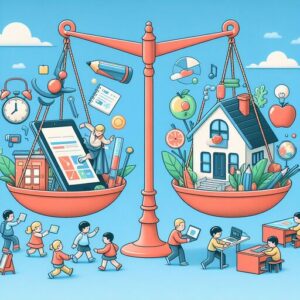In the realm of education, the rise of technology has brought about significant changes in how students learn and teachers instruct. Educational tablets, with their interactive features and vast array of learning apps, have become increasingly popular tools in classrooms and homes. However, they also raise questions about their effectiveness compared to traditional learning methods. In this article, we will explore the pros and cons of educational tablets versus traditional learning methods, examining their impact on student engagement, academic outcomes, and overall learning experiences.

Accessibility and Convenience:
Educational Tablets:
-
- Pros: Educational tablets offer unparalleled accessibility to learning resources and materials. Students can access digital textbooks, educational apps, and online resources from anywhere with an internet connection, enabling learning beyond the confines of the classroom.
- Cons: While tablets provide convenience, they may also lead to over-reliance on technology and reduced opportunities for hands-on learning experiences.
Traditional Learning Methods:
-
- Pros: Traditional learning methods, such as textbooks and physical materials, are tangible and readily available in most educational settings. They do not require access to technology and can be used in various environments, including areas with limited internet connectivity.
- Cons: Traditional learning methods may lack the interactivity and multimedia features offered by educational tablets, potentially limiting student engagement and exploration.
Engagement and Interactivity:
Educational Tablets:
-
- Pros: Educational tablets provide interactive learning experiences through multimedia content, gamified activities, and adaptive learning platforms. They engage students through hands-on exploration, immediate feedback, and personalized instruction tailored to individual learning styles.
- Cons: Excessive screen time and distractions from non-educational apps or content may diminish student focus and attention during tablet-based learning activities.
Traditional Learning Methods:
-
- Pros: Traditional learning methods encourage active participation and engagement through hands-on activities, group discussions, and experiential learning opportunities. They foster social interaction, collaboration, and critical thinking skills.
- Cons: Traditional learning methods may lack the dynamic and immersive features of educational tablets, making it challenging to accommodate diverse learning preferences and adapt to individual student needs.
See price for All-new Fire HD 8 Kids Tablet Bundle. Includes Fire HD 8 Kids Tablet |Disney Princess & Made For Amazon PlayTime Volume Limiting Bluetooth Kids Headphones Age (3-7)|Purple https://amzn.to/49btwcJ
Customization and Personalization:
Educational Tablets:
-
- Pros: Educational tablets offer personalized learning experiences tailored to each student’s pace, preferences, and abilities. Adaptive learning algorithms track student progress, adjust content based on performance, and provide targeted remediation or enrichment.
- Cons: Personalized learning algorithms may rely on standardized assessments and metrics, potentially overlooking the holistic development and individual strengths of students.
Traditional Learning Methods:
-
- Pros: Traditional learning methods allow for flexibility and customization in teaching approaches, enabling teachers to adapt instruction based on student needs, interests, and learning styles. Teachers can differentiate instruction, provide individualized support, and offer alternative learning pathways.
- Cons: Customization in traditional learning methods may require additional time and resources for lesson planning, materials preparation, and differentiation, limiting scalability and efficiency in larger classroom settings.
Feedback and Assessment:
Educational Tablets:
-
- Pros: Educational tablets provide immediate feedback on student performance, allowing for timely assessment and intervention. Teachers can track student progress, analyze learning data, and identify areas for improvement through built-in assessment tools and learning analytics.
- Cons: Automated feedback generated by educational tablets may lack the nuance and context provided by human instructors, potentially leading to misinterpretation or oversimplification of student responses.
Traditional Learning Methods:
-
- Pros: Traditional learning methods enable teachers to provide personalized feedback, guidance, and support to students through verbal interactions, written comments, and assessments. Teachers can assess student understanding, address misconceptions, and offer constructive feedback in real-time.
- Cons: Traditional assessment methods, such as written tests or quizzes, may be time-consuming to administer and grade, limiting opportunities for frequent assessment and feedback.
Cost and Accessibility:
Educational Tablets:
-
- Pros: Educational tablets offer cost-effective solutions for accessing digital learning resources, reducing the need for purchasing physical textbooks and materials. They can be shared among multiple students and updated with new content over time.
- Cons: The initial cost of purchasing educational tablets and maintaining technology infrastructure may be prohibitive for some schools or families, particularly in low-income communities with limited access to technology.
Traditional Learning Methods:
-
- Pros: Traditional learning methods are relatively affordable and accessible, requiring minimal technology infrastructure or ongoing maintenance costs. Physical textbooks, workbooks, and classroom supplies are widely available and can be reused across multiple academic years.
- Cons: The cost of purchasing and replacing physical materials, such as textbooks, laboratory equipment, and classroom resources, can add up over time, especially for schools with limited budgets or outdated resources.
See price for DOOGEE T10 Android Tablet 2K HD 10.1 inch, 8+7GB RAM 128GB ROM(TF 1TB), Octa-Core Android 12 OS, Battery 8300mAh, 2.4/5G WiFi&Bluetooth 5.0, 13MP+8MP Camera, TÜV Low Bluelight Tablet for Kids (Blue) https://amzn.to/3vzxhLb
In conclusion, the comparison between educational tablets and traditional learning methods reveals a complex landscape of advantages and challenges for educators, students, and families. While educational tablets offer accessibility, interactivity, customization, immediate feedback, and cost-effective solutions, they also pose concerns about screen time, distractions, personalized learning algorithms, and technological barriers. On the other hand, traditional learning methods emphasize hands-on experiences, social interaction, teacher-student relationships, personalized feedback, and affordability, but may lack the dynamic and adaptive features of educational tablets. Ultimately, the choice between educational tablets and traditional learning methods depends on the specific needs, preferences, and resources of each educational context, highlighting the importance of thoughtful integration and balanced approaches to maximize learning outcomes for all students.

